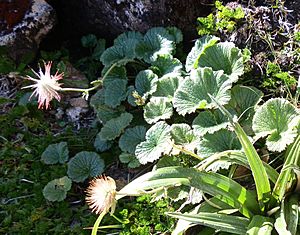Tasmanian snowrose facts for kids
Quick facts for kids Tasmanian snowrose |
|
|---|---|
 |
|
| Scientific classification |
The Tasmanian snowrose (scientific name: Geum talbotianum) is a very special plant. It is a type of perennial herb, which means it lives for more than two years. It grows in a rosette shape, like a flat circle of leaves. You can only find this plant in Tasmania, Australia. It loves to live high up in the rocky mountains of Southern Tasmania.
What Does the Tasmanian Snowrose Look Like?
This plant is quite small. Its leaves are wide, shaped like kidneys. They are about 5 to 10 centimeters across. The top of the leaves looks a bit wrinkled. They also have tiny, soft hairs. These leaves grow on stalks right from the bottom of the plant.
The flowers of the Tasmanian snowrose are big and white. They can be 4 to 5 centimeters wide. These beautiful flowers appear on long stalks, called peduncles. You can usually see them blooming from late December to early March. After the flowers, the plant produces red, soft berries.
Where Does the Tasmanian Snowrose Live?
The Tasmanian snowrose only grows in high alpine areas. These are very cold and windy places. You can find it in Southwest Tasmania. It often hides in cracks and small spaces in rocky areas. This helps protect it from the harsh weather.
Some of the main places where you might spot this plant include Adamsons Peak and Mt Anne. It also grows in the Western Arthurs, Mt La Perouse, and Mt Piction. You can even find it at the Devils Backbone, which is in the Hartz Mountains National Park.
Why is the Tasmanian Snowrose in Danger?
The Tasmanian snowrose is listed as a rare plant. This means it is protected by the Threatened Species Protection Act 1995 in Tasmania. Because it only lives in a few places, it is very sensitive to changes. Both human activities and natural events can harm it.
Here are some of the dangers it faces:
- Climate Change: Warmer temperatures from climate change can shrink its mountain home. This means less space for the plant to grow.
- Bushfires: Big fires can destroy many plants in one area. This could wipe out a whole group of snowroses.
- Trampling: People who enjoy outdoor recreation like hiking might accidentally step on the plants. This can easily damage or kill them.

